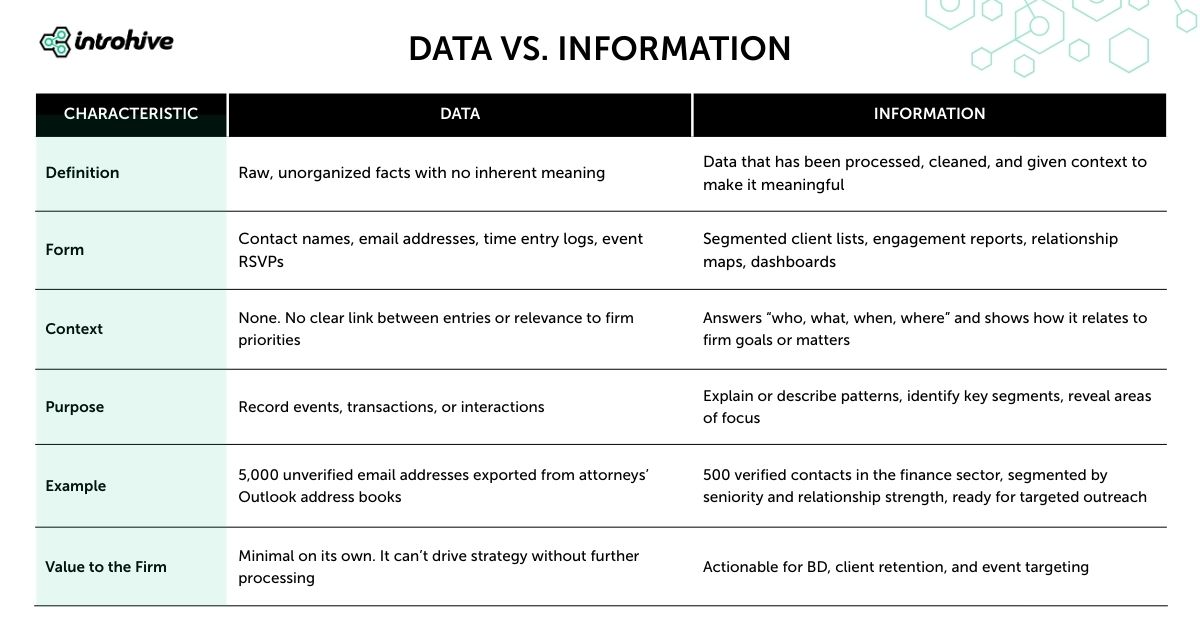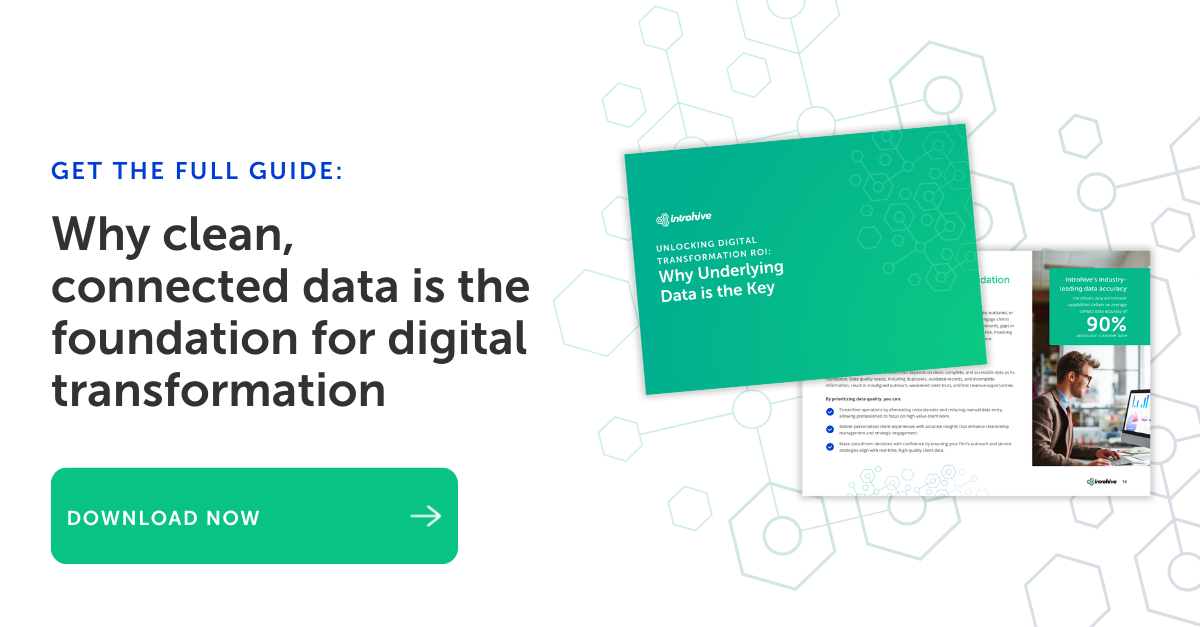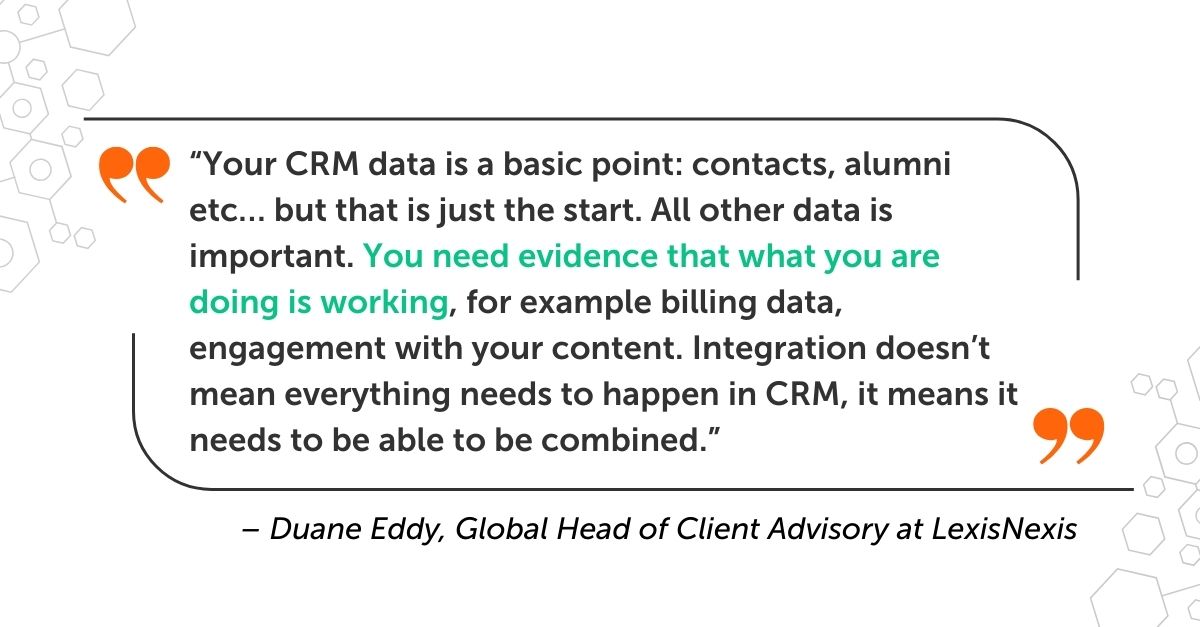As law firms look ahead to 2025, the focus is shifting from simply adding more contacts to building deeper, more strategic relationships with clients, prospects, and alumni. Moving from data, information, and knowledge to intelligence is where the real transformation happens, making growth more intentional and focused on the best opportunities.
That shift was at the center of our recent webinar with LexisNexis, Unlocking Data-Driven Growth: Integrating Introhive and InterAction for CRM Success, where panelists Celine Gilmore, Senior BD Director from Davies Ward Phillips & Vineberg LLP, Matt Lewis, CRM Manager at Osborne Clarke, Adam Stewart, Vice President, GTM Solutions at Introhive, and Duane Eddy, Global Head of Client Advisory at LexisNexis explored how automation and relationship intelligence turn disconnected facts into actionable data.
The webinar touched on many practical challenges and solutions, but one theme came up repeatedly. In many law firms, data is still siloed and unstructured, making it difficult to turn into usable information and insights. This often happens because CRM tools are underused and automation is limited.
In this context, the question of ‘what is data and information?’ is less about defining terms, and more about understanding how to move to integrated intelligence that supports business development and client relationships. Watch the full recording here.
Table of contents
What is data?
Many people use the terms interchangeably, but what is data and information in the context of a law firm? Data is the constant stream of unfiltered facts that flows in from client interactions, billing systems, emails, case notes, event sign-ups, and countless other sources. On its own, it’s just a mass of disconnected entries: a partner’s LinkedIn connection, a conference attendee list, a record of billable hours.
Without context or meaning, data sits in separate systems, often with gaps or duplicates that make it hard to get a complete view. Many firms are buried in data but lack clarity, especially when it’s scattered across siloed platforms, subject to human error, and difficult to reconcile. In practical terms, data and information are connected stages of the same process, not interchangeable labels.
Key characteristics of data (raw, discrete, no meaning on its own)
- It is unprocessed and has not been organized or interpreted.
- It lacks context, telling you what happened but not why or how it matters.
- It often comes in large volumes that are hard to sift through for answers.
- It is vulnerable to errors, especially when people have to enter it manually across different systems.
Simple examples of data (list of temperatures, list of names, website visitor counts)
- A spreadsheet of every contact from attorneys’ Outlook address books.
- Raw time entry logs for all matters in a given month.
- The RSVP list for a firm networking event without any indication of client status or potential value.
- Email open rates for a client alert without knowing who the recipients are or what practice area they care about.
What is information?
In a law firm, information is the result of raw data that’s been cleaned, connected, and given context so it can guide decisions.Instead of scanning hundreds of disconnected contact records, email lists, or feedback forms, you see the bigger picture: who the contact is, their role, their engagement history, and the most recent interactions with your firm. At Davies, Celine described this shift as moving from siloed, inconsistent inputs to integrated, organized records that surface key insights: for example, from a client service feedback form, the notes from a partner’s trip, the business development memos, etc. With this level of processing, the data starts answering questions like who are our most valuable contacts, which clients are most engaged, and where should we focus our outreach next?

Key characteristics of information (processed, contextualized, has meaning)
- It has been organized so it’s consistent and usable across departments.
- It includes context that explains who or what the data points relate to.
- It is accurate and reliable enough to inform business decisions.
- It allows you to identify patterns, trends, or gaps in relationships.
Simple examples of information (a list of your top 10 customers, a report on last month’s website traffic by source, etc.)
Simple examples of law firm data (before it is cleaned or given context)
- A spreadsheet of every contact from attorneys’ Outlook address books.
- Raw time entry logs exported from the billing system for all recorded client work in a given month.
- The RSVP list for a firm networking event without any indication of client status, relationship to the firm, or potential value.
- Email open rates for a client alert without knowing who the recipients are or which practice area they care about.
- An export of recent client meetings from attorneys’ calendars without attendee details, meeting purpose, or related matters.
- A marketing automation report showing click-through counts without linking them to specific contacts or accounts.
The key differences: data vs. information at a glance
The phrase data vs information might sound academic, but in a law firm setting, recognizing the difference between data and information can change how your CRM drives growth. That’s where most law firms start to see real progress in their CRM strategy. Raw data might tell you that a partner met with a contact last month, or that an event had 120 attendees. Once that data is processed and given context, you know who attended, what their relationship is to the firm, and when they last engaged with your team.
During the webinar, Matt described how this plays out in practice at Osborne Clarke. Their attorneys receive automated digests before and after meetings, giving them not just a contact’s name, but also their firm connections and recent activity. These insights are delivered directly into inboxes, so attorneys don’t have to log in to another system to prepare for a meeting.
“Introhive’s automated digest emails and the pre- and post-meeting notes are really invaluable in that the information goes straight into users’ inboxes so they don’t have to leave Outlook for that.”
In one example, his colleague Ruth was running a training session in the firm’s Italy office. While demonstrating the digest tools, a user spotted that an internal contact knew one of their key external contacts, a connection they hadn’t been aware of.
“That then started a conversation: ‘I didn’t know that this person in the London office also knew one of my contacts and they’ve been speaking to them about certain information.’ And that then sparked a conversation, and we have many examples like that.”
That’s the moment when raw, isolated data like a contact name in the CRM becomes valuable information that can lead to collaboration and opportunity.
Here’s how data and information compare at a glance:

From theory to practice: a business example in your CRM
For many law firms, recognizing the difference between data and information is the first step to unlocking the full potential of their CRM systems. CRM systems are full of potential but underused because the data inside is incomplete, outdated, or unstructured. Without processing and context, it’s just a list of names and addresses. But once that raw data is organized into information, it becomes a tool your teams can actually use.
CRM data
A law firm’s CRM might hold 5,000 email addresses collected from attorney address books, event registrations, and client interactions. On their own, those records don’t tell you much. Many will be out of date. Others may be duplicates. Without additional context, they’re just entries in a database.
CRM information
Now imagine that same list after it’s been cleaned, de-duplicated, and enriched with context from billing systems, practice group notes, and email engagement data. Suddenly, you can see that 500 of those contacts work at Fortune 500 companies in the finance sector, 200 attended a recent client seminar, and 75 are alumni now in leadership roles at prospective client organizations – actionable data your business development team can use immediately.
This is the stage where, as Celine Gilmore from Davies shared, relationship data helps you do more than just “fill a list”. Her team used relationship insights to curate an event specifically for decision-makers, board members, and C-level executives, resulting in a room full of influential people and new business opportunities.
Understanding the principles of data vs information ensures firms don’t waste time on unprocessed facts that can’t guide strategy. Once you’ve reached this point, the next question is: how do you go beyond “knowing” to “acting”? That’s where the concept of Intelligence comes in.
The missing piece: turning information into intelligence
Information tells you what’s happening. Intelligence tells you why it matters and what to do next. In a law firm, that’s the difference between knowing that a contact is a Fortune 500 GC in the finance sector, and knowing that your team already has strong, established relationships with their board members, and that those connections can open the door to a meeting.
Intelligence is the evolution of data information knowledge into targeted insights, much like customer intelligence, but designed for the unique relationship-driven growth challenges law firms face.
Intelligence connects the dots between relationships, opportunities, and strategic goals. It doesn’t just describe your network; it provides actionable data that guides business development strategies like how to win new matters, expand into new practice areas, or mitigate risk with at-risk clients.
The CRM intelligence example
Knowing that your attorneys have the strongest collective relationship score with the VPs in that list of 500 finance contacts and that you should prioritize them for your next high-value event or targeted outreach, is Intelligence in action.
As Adam explained it in the webinar:
“When we talk with firms about relationship intelligence, we mean a system that identifies, scores and maps those relationships that the firm has with the outside world… it creates a relationship graph, puts that into a system of record, and provides valuable insights based on that data and signals on that information. It brings the insights to you when and where you work – all without requiring a bunch of manual data entry.”

This means the CRM becomes more than a static repository. It becomes a living, dynamic map of your firm’s reach, highlighting not only where opportunities exist but also where white space remains. In practice, that could mean spotting:
- A former client contact who’s just moved into a GC role at a target company.
- A lateral hire whose network overlaps with a key strategic prospect.
- A dormant client relationship that’s at risk but still connected through multiple touchpoints in the firm.
In short, Intelligence is actionable. It’s the bridge between knowing and doing, turning your CRM from a static database into a true data intelligence platform that drives growth.
Specifically: what is relationship intelligence?
Relationship Intelligence, a specialized and relationship-driven form of customer intelligence, is the ability to see, score, and understand the strength of the connections your firm already has – and to know how to use them. It goes beyond “who knows who” to measure the depth of those relationships and identify the best path to new opportunities.
In practical terms, it means pulling together every touchpoint your attorneys, staff, and alumni have with the outside world: client work, networking events, charitable boards, alumni networks, and even informal introductions. This data is then enriched with context, who the contact is, their current role, how they’ve engaged with your firm, and transformed into insights that guide growth strategies.
As Adam explained in the webinar, it’s a process that happens behind the scenes:
“It understands that people and their jobs and their relationships change over time… and it brings the insights based on that information to you when and where you work. And it does all this without requiring people to do a bunch of data entry.”

Duane from LexisNexis emphasized why this matters in CRM adoption:
“Adoption doesn’t necessarily mean people are logging in to the CRM. If the data is being used anywhere to build your business, that is adoption.”
For Celine at Davies, Relationship Intelligence is central to BD efforts:
“It’s at the heart of everything we do… We use it to identify the right mix of clients and prospects for high-value events, to support partners in their travel planning, and to make sure we’re always leveraging the firm’s strongest connections.”
By automating the process of gathering, cleaning, and connecting relationship data, firms can free up partners and fee earner to focus on strategy.
For many firms, the biggest challenge isn’t the technology itself, but helping partners and fee earners understand why capturing this information matters. Osborne Clarke tackled this by making training role-specific, showing professionals exactly how the insights would help in their day-to-day work.
At Davies, the marketing and BD team took a more direct approach. Knowing the firm needed comprehensive relationship intelligence to support partners, they secured leadership buy-in and began capturing data behind the scenes. As partners engaged with the BD team, they received more complete, sophisticated answers to their questions, which in turn built trust and kept them coming back for more.
In both cases, the key was reframing data capture from a compliance exercise into a clear business benefit: better insights, stronger relationships, and more opportunities surfaced with less effort.
How to build an intelligence engine for your business
Turning raw data into actionable Intelligence is a step-by-step process and each stage builds on the one before it. You can’t have Intelligence without clean, accurate Information, and you can’t have that without comprehensive data. Firms that want to move from data information knowledge to true intelligence need the right processes and tools in place.
Here’s what the value chain looks like in a law firm, from comprehensive data to clean, contextualized information, all the way to true data intelligence.
1. Comprehensive data
Start by ensuring you have all the relevant contact and engagement points in one place. This means pulling from multiple systems: CRM, email, time and billing, marketing automation, event management so that you aren’t working from incomplete records.
As Duane noted in the webinar, contact and alumni data is just the beginning:
“Your CRM data is a basic point: contacts, alumni etc… but that is just the start. All other data is important. You need evidence that what you are doing is working, for example billing data, engagement with your content. Integration doesn’t mean everything needs to happen in CRM, it means it needs to be able to be combined.”

2. Clean, contextualized information
Once the data is gathered, it needs to be processed, deduplicated, and enriched with context.
As Celine shared, this is often the toughest step:
“Every department is doing things differently… the good data is in the client service feedback forms, the BD memos from trips and visits… figuring out how to get that in a system and align across all departments was the real work.”
3. Automated intelligence
With clean information in place, platforms like Introhive can apply scoring, mapping, and enrichment to surface relationship insights in real time. This is where actionable intelligence happens, knowing which relationships are strongest, which opportunities have the most potential, and where white space exists.
At Osborne Clarke, Matt has taken this a step further by integrating Introhive and InterAction data into Power BI dashboards.
“We’re in the process of integrating Introhive and InterAction data as well as our email marketing data into a dashboard so that that can be sliced by client, selected by client, so that we have the client view of all key information.”
When these three layers are working together, your CRM shifts from being a static database to a true data intelligence system that actively supports BD efforts, client retention, and strategic growth.
If you’re ready to bring all your firm’s relationship data together and actually see where the best opportunities are, let’s talk. Book a demo to see how Introhive helps uncover warm connections, strengthen key client relationships, and surface new opportunities via data intelligence – without adding extra work for your team.
Want to see how other firms are doing it? Watch the full webinar with Davies, Osborne Clarke, and InterAction for real-world examples and results.





